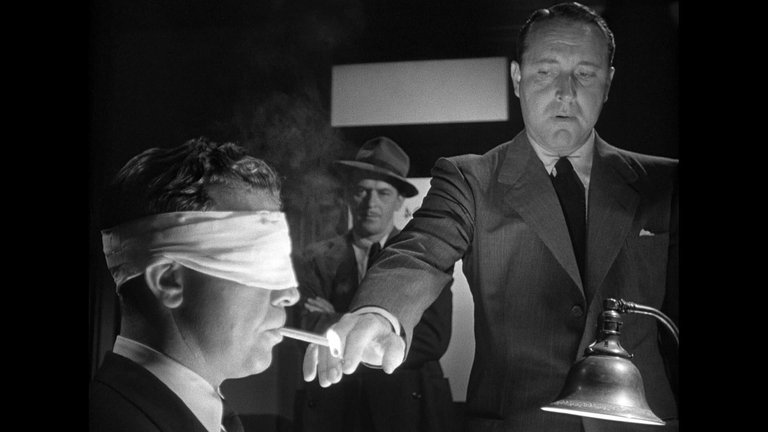Film Review: Murder, My Sweet (1944)

1944 was one of the better years for Hollywood and among the best for film noir. Genre-defining Double Indemnity was accompanied by number of film noirs that would earn notable places in film history books. One of those was Murder, My Sweet, film directed by Edward Dmytryk, also known as the first to feature private detective Philip Marlowe as the protagonist.
The film is based on Farewell, My Lovely, 1940 novel by Raymond Chandler that was the second in his Marlowe series. It was first adapted in 1942, but only as plot for The Falcon Takes Over, third film in the series starring George Sanders as suave amateur detective Gay Lawrence. 1944 is the first “proper” adaptation with Marlowe as actual protagonist, here played by Dick Powell. The plot begins when Marlowe, temporarily blinded by gun flash, gives statement by police about complicated case he was involved in. Through flashbacks we see how it all started when Moose Malloy (played by Mike Mazurki), huge ex-convict, hires him to locate Velma Valento, girlfriend who disappeared while he was serving prison sentence. Marlowe reluctantly takes the case and even more reluctantly agrees to serve as bodyguard for effeminate Lindsay Marriot (played by Douglas Walton) who wants to buy back stolen jewels. Marriot gets killed during exchange and Marlowe becomes possible suspect. Trying to clear his name, he investigates and finds that the case might have something to do Jules Amthor (played by Otto Kruger), sinister self-declared psychic healer, while beautiful Ann Grayle (played by Anne Shirley) wants him to stop investigating. Marlowe discovers that the jewels were apparently owned by Ann’s weak old father Leuwen (played by Miles Mander) whose young, attractive and apparently promiscuous wife Helen (played by Claire Trevor) might have been the object of blackmail.
Murder, My Sweet was produced by RKO Pictures with relatively low budget, but it doesn’t show, at least not for more experienced viewers. Experienced director Edward Dmytryk handles limited resources very well and creates distinctively noirish atmosphere through nighttime cinematography and series of sets. Tempo is fast but audience wouldn’t have problems of following relatively complicated plot that involves number of large characters with different agendas. The most noirish thing about Murder, My Sweet is snappy Chandleresque dialogue by scriptwriter John Paxton, especially when told by protagonist in voice-over in the recognisable genre tradition. Dmytryk also shows ability to go beyond conventions in the scene when Marlowe is forcefully drugged and has bad dreams and hallucinations – a scene that was, until that point, unusual for 1940s Hollywood.
Murder, My Sweet benefits a lot from good cast. Dick Powell, actor and singer who was at the time best known for light comedies and musicals like 42nd Street, was losing his boyish looks at the time and desperately wanted to show broader acting range. After unsuccessful attempt to land main role in Double Indemnity (snatched by Fred MacMurray) he settled for Marlowe as consolation prize and made the best of it. His role of tough, world-weary and cynical private detective is not the most iconic or most memorable of all Marlowe’s screen incarnations, but it was more than good enough to do the job. Powell was so impressive that was cast in series of other film noirs and similar films where he played “tough guys”. His female were somewhat less impressive – Anne Shirley is somewhat bland in the role of “good”, while Claire Trevor is only slightly better in the role of vampish “bad girl”. General impression is improved by supporting players, most notably Mike Mazurki, professional wrestler who was quite intimidating in the role of gigantic man whose size and ability for violence was proportional with his ability to be manipulated. Murder, My Sweet is, like all 1940s film noirs, partially constrained by strict censorship standards of Hays Code and doesn’t live up to high standards set by Double Indemnity. Yet, it is more than well-made, short and easily digestible genre classic that could be still enjoyed by today’s audience. In 1975 Chandler’s novel received new adaptation under its original title starring Robert Mitchum.
RATING: 7/10 (+++)
Blog in Croatian https://draxblog.com
Blog in English https://draxreview.wordpress.com/
Leofinance blog https://leofinance.io/@drax.leo
Stars Arnea: https://www.starsarena.com/?ref=draxblog
Unstoppable Domains: https://unstoppabledomains.com/?ref=3fc23fc42c1b417
Hiveonboard: https://hiveonboard.com?ref=drax y
Bitcoin Lightning HIVE donations: https://v4v.app/v1/lnurlp/qrcode/drax
Rising Star game: https://www.risingstargame.com?referrer=drax
1Inch: https://1inch.exchange/#/r/0x83823d8CCB74F828148258BB4457642124b1328e
BTC donations: 1EWxiMiP6iiG9rger3NuUSd6HByaxQWafG
ETH donations: 0xB305F144323b99e6f8b1d66f5D7DE78B498C32A7
